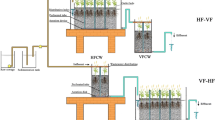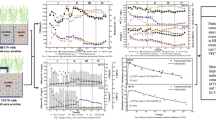Abstract
The issue of urban river pollution has attracted great attention due to high concentrations of ammonia nitrogen (NH4+-N) and low concentrations of dissolved oxygen (DO) in polluted water bodies. In order to investigate the effects of aeration-enhanced horizontal subsurface-flow constructed wetlands on polluted river water, unaerated aeration (NA), continuous aeration (CA), and intermittent aeration (IA) constructed wetlands were established. The purification effects of the wetland on various pollutants and the form of effluent nitrogen, influences of temperature on the removal rates of pollutants, the change of redox potential—oxidation reduction potential (ORP)—and the difference of dissolved oxygen (DO) between influent and effluent were investigated. The results indicated that aeration enhancement can improve the purification efficiencies of chemical oxygen demand (COD) and NH4+-N in constructed wetlands. The purification efficiencies of TN in IA and CA constructed wetlands were 91.9% and 53.7%, respectively, indicating that IA is the optimized aeration method for removal of various pollutants in wetlands. Changes of DO and ORP in effluent under IA and CA suggested improvement of aeration on the water environment. Meanwhile, DO was more sensitive to temperature compared with ORP. Additionally, a study of the nitrogen content in effluent suggested that the aeration method had a significant influence on the nitrogen content in effluent. The removal rates of both NH4+-N and TN degraded as the temperature dropped. The results also demonstrated that the removal rate of NH4+-N under aeration condition was more sensitive to temperature than that under NA condition and the effect of temperature on the removal rate of NH4+-N was greater than that of TN.











Similar content being viewed by others
References
Akratos CS, Tsihrintzis VA (2007) Effect of temperature, HRT, vegetation and porous media on removal efficiency of pilot-scale horizontal subsurface flow constructed wetlands. Ecol Eng 29:173–191
Almuktar SAAAN, Abed SN, Scholz M (2018) Wetlands for wastewater treatment and subsequent recycling of treated effluent: a review. Environ Sci Pollut Res 25:23595–23623
Billore SK, Singh N, Ram HK, Sharma JK, Singh VP, Nelson RM, Dass P (2001) Treatment of a molasses based distillery effluent in a constructed wetland in Central India. Water Sci Technol 44:441–448
Cheng QL, He Y, Huang MS et al (2011) The discussion on the treatment methods of urban Malodorous River. Shanghai Chem Ind 36:25–31
Cookson WR, Cornforth IS, Rowarth JS (2002) Winter soil temperature (2-15°C) effects on nitrogen transformations in clover green manure amended or unamended soils; a laboratory and field study. Soil Biol Biochem 34:1401–1415
Du G, Huang L, Gao X et al (2013) Number of microbe and relationship between it and removal of pollutants in constructed wetlands. Wetland Science 11:13–20
Edwards KR, Cizkova H, Zemanova K et al (2006) Plant growth and microbial processes in a constructed wetland planted with Phalaris arundinacea. Ecol Eng 27:153–165
Fan JL, Zhang B, Zhang J, Ngo HH, Guo W, Liu F, Guo Y, Wu H (2013) Intermittent aeration strategy to enhance organics and nitrogen removal in subsurface flow constructed wetlands. Bioresour Technol 141:117–122
Gabriel ML, Roxane M, Jacques B et al (2009) Nitrogen transformations and retention in planted and artificially aerated constructed wetlands. Water Res 43:535–545
Guo YY, Yang SY, Huang Y et al (2014) Effect of intermittent aeration on performance of nitrogen removal in domestic wastewater treatment by subsurface constructed wetlands. Chinese J Environ Eng 8:1405–1409
Han YZ, Nian Y (2009) Research on influence of pollutant loading and composition on total nitrogen removal in subsurface flow constructed wetland system. Environ Sci Technol 22:1–5
Hu HB (2011) Study on nitrogen removal characteristics of anaerobic-oxic biological filter conbination process for municipal sewage treatment. Dissertation, Harbin Institute of Technology
Huang J, Hagedorn C, Reneau RB (2000) Nitrogen removal in constructed wetlands employed to treat domestic wastewater. Water Res 34:2582–2588
Huang JL, Chen Q, Xu LH (2013) Problems and countermeasures in the application of constructed wetlands. Environ Sci 34:401–408
Hyun K, Choi J, Ki D et al (2015) Bathroom wastewater treatment in constructed wetlands with planting, non-planting and aeration, non-aeration conditions. Desalin Water Treat 57:709–717
Jin ZJ, Zhang CM, Yang FL et al (2013) Construction and engineering practice of ecological restoration technology system for reducing pollution in the typical Urban River. Environ Sci Technol 36:295–298
Job GD, Biddlestone AJ, Gray KR (1991) Treatment of high strength agricultural and industrial effluents using reed bed treatment systems. Chem Eng Res Des 69:187–189
Kadlec RH, Wallace SD (2009) Treatment wetlands. CRC Press, New York
Lee CG, Fletcher TD, Sun GZ (2009) Review: nitrogen removal in constructed wetland systems. Eng Life Sci 9:11–22
Li JB (2008) Wastewater treatment using enhanced hybrid constructed wetland system of vertical-flow and horizontal-flow. Dissertation, Tongji University of Shanghai
Lin YF, Jing SR, Wang TW, Lee DY (2002) Effects of macrophytes and external carbon sources on nitrate removal from groundwater in constructed wetlands. Environ Pollut 119:413–420
Liu HQ, Hu Z, Zhang J, Ngo HH, Guo W, Liang S, Fan J, Lu S, Wu H (2016) Optimizations on supply and distribution of dissolved oxygen in constructed wetlands: a review. Bioresour Technol 214:797–805
Lu SY, Jin XC, Yu G (2006) Nitrogen removal mechanism of constructed wetland. Acta Ecol Sin 26:2670–2677
Lu YP, Xu QX, Yang K et al (2010) Environmental value of urban river eco-restoration and its realization. J Hydraul Eng 41:278–285
Ma J, Peng YZ, Wang L et al (2008) Effect of temperature on denitrification and profiles of pH during the process. China Environ Sci 28:1004–1008
Maltais-Landry G, Maranger R, Brisson J (2009) Effect of artificial aeration and macrophyte species on nitrogen cycling and gas flux in constructed wetlands. Ecol Eng 35:221–229
Nie ZD, Nian YG, Li LF et al (2006) Effect of hydraulic loading and seasonal fluctuation on pollution removal of constructed wetlands. Water & Wastewater Engineering 32:28–31
Nivala J, Hoos MB, Cross C, Wallace S, Parkin G (2007) Treatment of landfill leachate using an aerated, horizontal subsurface-flow constructed wetland. Sci Total Environ 380:19–27
Nivala J, Wallace S, Headley T, Kassa K, Brix H, Afferden MV, Müller R (2013) Oxygen transfer and consumption in subsurface flow treatment wetlands. Ecol Eng 61:544–554
Shen ZQ, Mou R, Li YZ et al (2016) Study on the rapid adsorption regeneration-performance of bio-zeolite and its regeneration mechanism in a constructed wetland. Acta Sci Circumst 36:1242–1247
Stefanakis AI, Akratos CS, Gikas GD, Tsihrintzis VA (2009) Effluent quality improvement of two pilot-scale, horizontal subsurface flow constructed wetlands using natural zeolite (clinoptilolite). Microporous Mesoporous Mater 124:131–143
Stottmeister U, Wiessner A, Kuschk P et al (2003) Effects of plants and microorganisms in constructed wetlands for wastewater treatment. Biotechnol Adv 22:93–117
Tang XQ, Huang SL, Scholz M, Li J (2009) Nutrient removal in pilot-scale constructed wetlands treating eutrophic river water: assessment of plants, intermittent artificial aeration and polyhedron hollow polypropylene balls. Water Air Soil Pollut 197:61–73
Tong K, Li G, Ji GD (2008) Seasonal removal efficiency studies on a subsurface flow constructed wetland for treating heavy oil produced water. Environ Eng 26:32–34
Uggetti E, Hughes-Riley T, Morris RH, Newton MI, Trabi CL, Hawes P, Puigagut J, García J (2016) Intermittent aeration to improve wastewater treatment efficiency in pilot-scale constructed wetland. Sci Total Environ 559:212–217
Voets JP, Vanstanen H, Verstroete W (1975) Removal of nitrogen from highly nitrogenous wastewater. J Water Pollut Control Fed 47:394–398
Vrhovsek D, Kukanja V, Bulc T (1996) Constructed wetland (CW) for industrial waste water treatment. Water Res 30:2287–2292
Vymazal J (2007) Removal of nutrients in various types of constructed wetlands. Sci Total Environ 380:48–65
Vymazal J (2009) The use constructed wetlands with horizontal sub-surface flow for various types of wastewater. Ecol Eng 35:1–17
Wang L, Li T (2015) Effects of seasonal temperature variation on nitrification, anammox process, and bacteria involved in a pilot-scale constructed wetland. Environ Sci Pollut Res 22:3774–3783
Wu JQ, Zhou XH, Wang M (2012) Influence of hydraulic retention time variation on purification effects of two different constructed wetlands. Chinese J Environ Eng 6:3537–3542
Wu P, Lu SJ, Xu LZ et al (2017) Efficiency and mechanism of nitrogen and phosphorus removal in modified zeolite wetland. Environ Sci 38:580–588
Xie F, Huang L, Gao X et al (2013) Purification efficiencies of subsurface horizontal flow constructed wetland treating slightly polluted river water. Chinese J Environ Eng 7:65–71
Xu L, Ge DB, Xie XK (2014) Impact of hydraulic retention time on wetland running. Chinese Agric Sci Bull 30:219–223
Yamamoto T, Takaki K, Koyama T et al (2008) Long-term stability of partial nitritation of swine wastewater digester liquor and its subsequent treatment by Anammox. Bioresour Technol 99:6419–6425
Yan ZY, Liao YZ, Li XD et al (2006) Progress in research of biological removal of nitrogen. Chinese J Appl Environ Biol 12:292–296
Yin XL, Zhang J, Hu Z, Xie H, Guo W, Wang Q, Ngo HH, Liang S, Lu S, Wu W (2016) Effect of photosynthetically elevated pH on performance of surface flow-constructed wetland planted with Phragmites australis. Environ Sci Pollut Res 23:15524–15531
Yoo H, Ahn KH, Lee HJ et al (1999) Nitrogen removal from synthetic wastewater by simultaneous nitrification and denitrification via nitrite in an intermittently-aerated reactor. Water Res 33:146–152
Zhang LY, Rao BQ, Xiong Y et al (2010a) The microbial mechanism of horizontal constructed wetland used to treated black-odor river. Acta Hydrobiologica Sinica 34:256–261
Zhang LY, Zhang L, Liu YD, Shen YW, Liu H, Xiong Y (2010b) Effect of limited artificial aeration on constructed wetland treatment of domestic wastewater. Desalination 250:915–920
Zhang RX, Liu R, Jiao YE et al (2018) Effect of low temperature on growth distribution and treatment efficiency of microorganisms in wetland fillers. Environ Pollut Control 40:387–391
Zhao FM, Hai RT, Han XL (2011) Optimizing substrate gradation and effect factors for constructed wetland removal of ammonia nitrogen. Environ Sci Technol 34:26–30
Zheng P, Xu XY, Hu BL (2004) New technology of biological removal of nitrogen. Science Press, Beijing
Funding
We greatly acknowledged the financial support from the Sichuan Provincial Department of Education (No. 2017SZ0177) and the State Key Laboratory of Geohazard Prevention and Geoenvironment Protection (SKLGP2016Z008).
Author information
Authors and Affiliations
Corresponding author
Additional information
Responsible editor: Philippe Garrigues
Publisher’s note
Springer Nature remains neutral with regard to jurisdictional claims in published maps and institutional affiliations.
Rights and permissions
About this article
Cite this article
Liu, G., He, T., Liu, Y. et al. Study on the purification effect of aeration-enhanced horizontal subsurface-flow constructed wetland on polluted urban river water. Environ Sci Pollut Res 26, 12867–12880 (2019). https://doi.org/10.1007/s11356-019-04832-9
Received:
Accepted:
Published:
Issue Date:
DOI: https://doi.org/10.1007/s11356-019-04832-9




